I had some extra time off in May, and opted to head north to Plattsburgh to take a Whitewater Safety & Rescue course. I’d also been hankering for a multi-day kayak camping trip, and was coming up short on nearby locations with easy camping.
Well, problem solved: Plattsburgh is on Lake Champlain, one of the largest natural freshwater lakes in the United States, and there is a watertrail association that publishes a book listing all the sites and their amenities, or lack thereof.
The course ended on a Monday, and I had to be back before Sunday, so that left . . . .five days of kayak camping. I’ve never done that many out of a kayak, and only come close doing so when car camping. This would be about the right size challenge I was looking for.
For the trip, I chose my Tiderace Pace 18. It’s lighter than the Argonaut and both roomier and faster than the Gemini SP. I’ve never camped out of the Pace 18, so I was kinda taking it on faith that I’d be able to fit everything into it. Basically, I loaded up the car and figured I’d do a test load before setting out.
Fortunately, that worked out. I’ll get into some details later about what worked and what didn’t, what I brought too much and too little of, but basically I was able to fit in:
- tent
- sleeping bag
- sleeping mat
- food for 5 days
- water for . . .3 days
- camping stove and fuel
- camp dishes
- clothes and layers
- charts and books
- toiletries and comfort items
As well, I had all the usual paddling kit on me – PFD, paddle, spare paddle, radio, sunscreen, etc. I’d also be carrying out my own garbage, so while I gained volume as I consumed supplies, I took up some of that with my own trash.
The water temperature was 48 F, and air temps ranged from the low 60s high down to upper 40s overnight. Since I was still waiting for my replacement drysuit, the coach who put together the WWSR course let me borrow one. This was on top of camping in his yard, using the guest shower and restroom, and taking some stove fuel. SM and his wife MM were very generous, and I’m very grateful for their support. This would have been a half-assed trip otherwise.
What follows, in block text, are entries from my handwritten log. I’ve added a bit of commentary and a few photos along the way. Unfortunately, my on-water camera died, and I forgot the waterproof case for my GoPro, so most of my photos are of camp sites.
Day 1
Set out from Peru (NY) town dock ~1115.
Weather predicted: F5+ NW, 60s F, p cloudy.
Weather actual: F4+ gusting to F5, 60s F, p cloudy. Nearby trees visibly swaying.
Packing went well. Everything fit, with one drybag in cockpit plus Tupperware. Sandals and a wet towel on deck. Paddled a bit into Sloop Cove. Windy near island. Went for a walk, about 90 minutes. West to the trail, followed north to Royal Savage Trail. Walked back after seeing wind gust the taller trees around. Looking across the water, whitecaps on the main lake. Near my little channel, a steady gurgling with occasional footers cresting over some rocks that would otherwise connect to a tiny rock island (Tiger Point). Talking in the distance. A tractor motor, or doors slamming.
A tractor motor, or doors slamming.
My campsite was on Tiger Point, about halfway up the eastern side of the island. To get there I paddled south from Peru, taking the wind at my tail and using the island as a bit of a wind shield coming around.
As far as I could tell I was the only human on the island, the lighthouse on the opposite side notwithstanding. While I was on the far shore, I was ultimately only a couple of miles from the county road on the mainland, so when the wind wasn’t blowing, I’d be able to hear modern noises.
That, and some natural sounds sound unnatural.
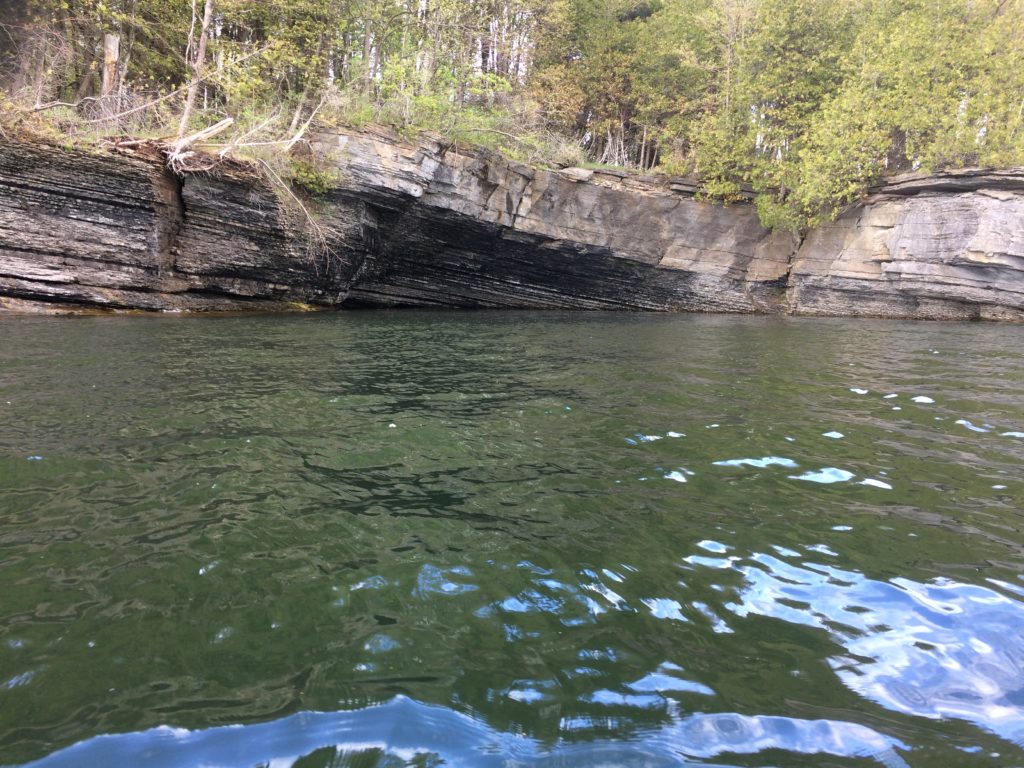
Valcour Island is where Benedict Arnold, then a General in the American army, fought a naval battle against the British during the Revolutionary War. Following the Battle of Valcour Island, the American fleet was badly damaged, but a thick fog settled in. Arnold and his men escaped by wrapping shirts around oarlocks and rowing past the British fleet. At one point, the British, led by one Guy Carleton, fired at what appeared to be the American fleet in the fog, but which turned out to be a small rocky island. It’s known today as Carleton’s Prize.
I didn’t know it at the time, but Royal Savage Trail is so named for Benedict Arnold’s flagship, the Royal Savage.
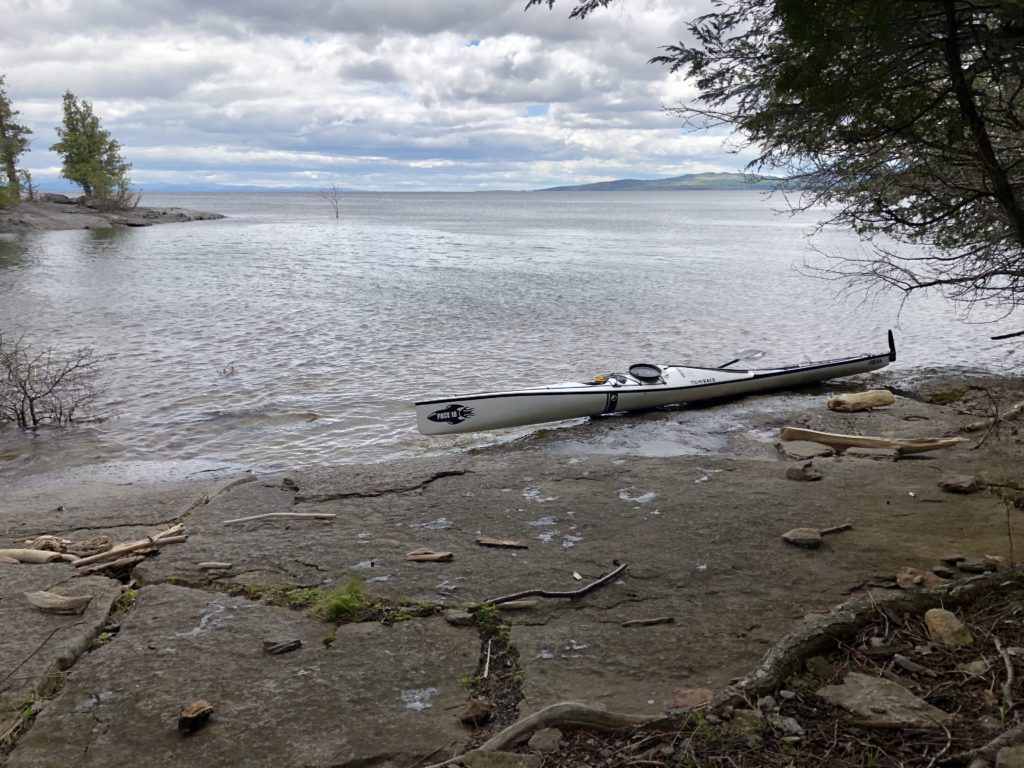
After I unloaded, I laid out two logs and set the boat up on them. Lake Champlain isn’t tidal, but with the overnight wind I knew waves might get up on shore, and in any case I wanted the boat high, dry, and not getting dragged around on rocky ground.
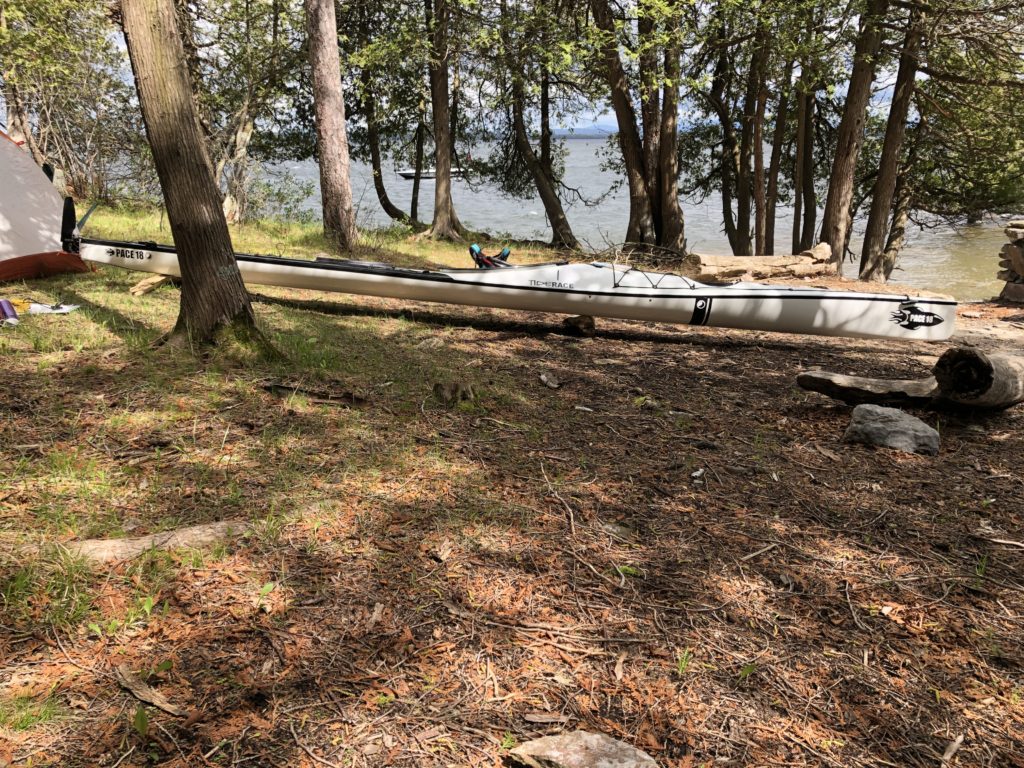
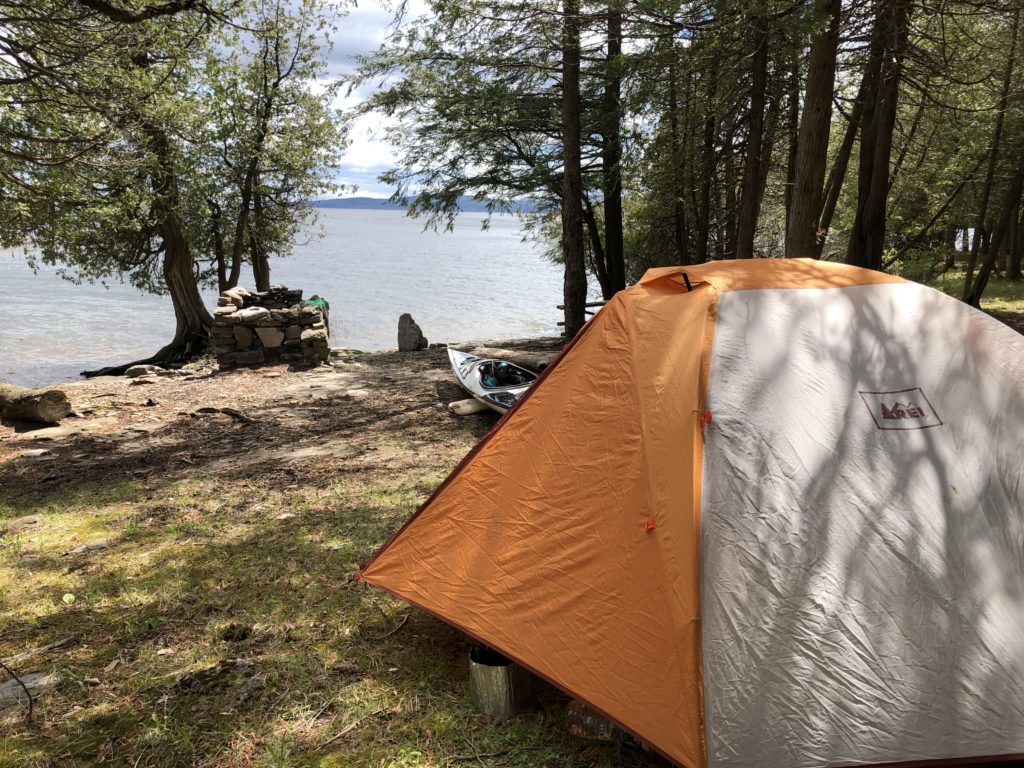
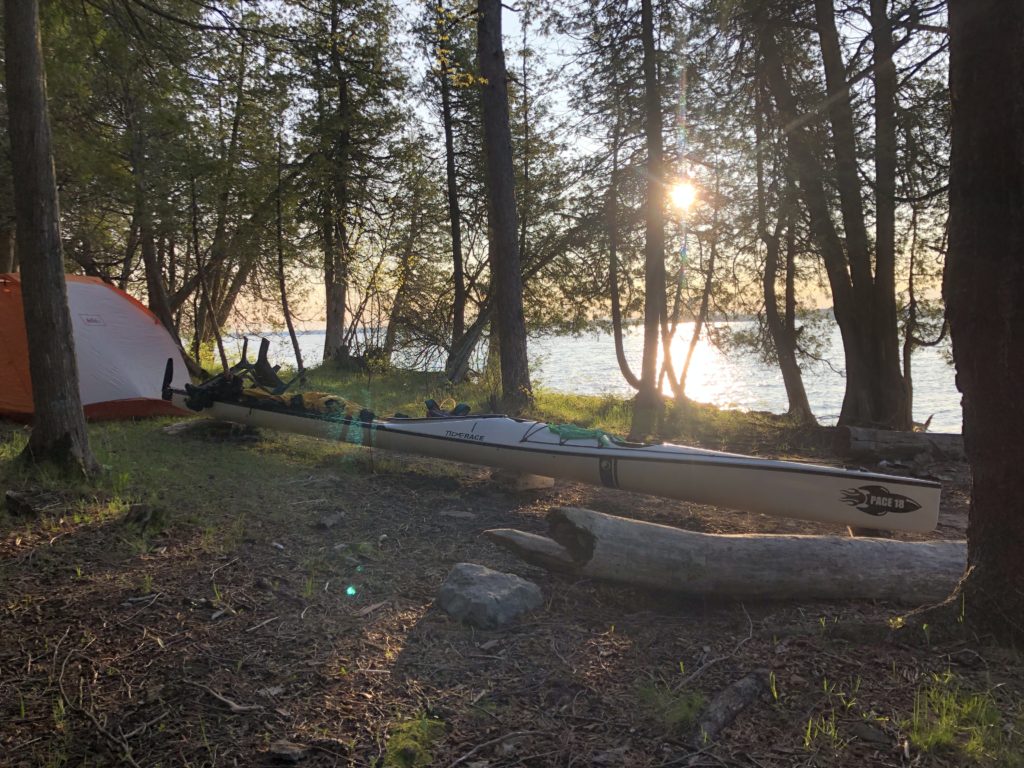
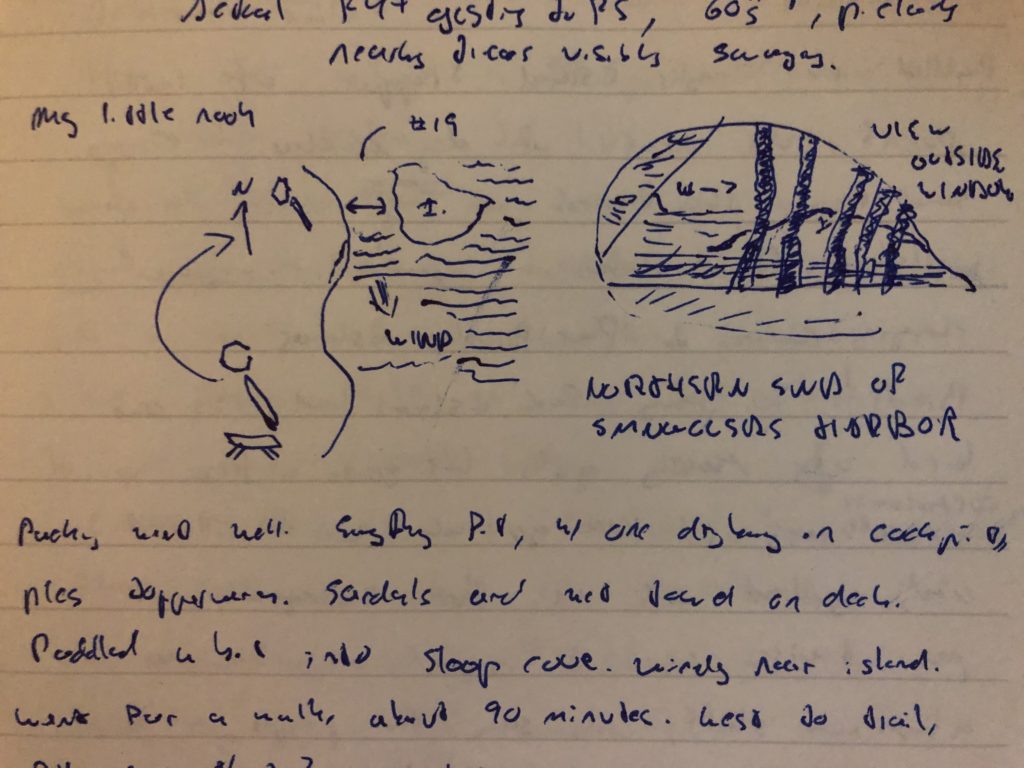
Day 2
Woke to songbirds singing before 5 AM.
Weather predicted: 64/50 F, F3 NE, Sunny.
Weather actual: pretty accurate, more like F2-F3.
Paddled to Schuyler Island. Stopped at a little point just north of a day marker on the east side. Short break, then towards Willsboro Point before changing course to Four Brothers islands.
Birds! So many. Each island had its own bird colony. Mostly gulls, but with quite a few cormorants as well. One gull was very territorial and swooped at me twice as I moved on. Saw an aluminum skiff (tied up on the island) but only saw people at a distance later, after I had paddled off.
Long way back. Five nautical mile crossing directly to Schuyler. Just about out of gas. Took eighty minutes plus ten minutes total of little breaks. Three and a half hours in the saddle altogether. Then, up to Trembleau Point, Au Sable River, a break, then three nautical mile crossing to Garden Ledge Island. Last 1-2 nautical miles so long, but a sustained burst for me back almost 9 hours exactly from when I set out.
It’s worth mentioning here that I made several long crossings. I know from previous experience that paddling farther away from shore, there’s less of a sense of progress. Think of it like traveling in an airplane, the ground appears to move much more quickly on takeoffs and landings than it does at cruising altitude. On the one hand, paddling close to shore can be interesting and keep up some mental sanity, but on the other hand, it can take longer in both time and distance.
Four Brothers was eleven nautical miles away from my campsite, meaning I did about twenty-two nautical miles roundtrip that day – without tidal assistance. That was far.
Day 3
Slept well. Well-rested.
Weather predicted: Partly cloudy 65/54. After 1000 F4 SSE. Also Friday (Day 4) predicted F5 NW 0800-1500, with rain chance spiking after 1500. Thunderstorms.
Weather actual: Burst of F5 south of Providence Island.
Holy Hell what a paddle. Three hours to get from Valcour to Law Island (about six nautical miles). Strong, strong headwind once I turned south. Broke me down two and a half hours in, I could see my destination but I was exhausted mentally and physically. Took a break, ate a snack bar and drifted backwards a bit, paddled on in silent resolve for half an hour. Next – head back out to get some potable water (after having set up camp).
LATER – I paddled to the town launch at the southernmost reach of Mallets Bay. About one and a half hours each way. Steady F4 abeam on the trip out pushed me way off course. On the way back, rain came at about 1630 and persisted until I landed around 1730. Stiff F4/F5 abeam across the bay. Once again mental fatigue set in with about a mile left. Am I losing endurance or is it that wind wears you down?
In the mission for potable water, I had to portage over a causeway, a former railroad that is now a trail.
After the second portage I noticed the rudder control was not working properly, and on closer inspection later, somehow the long pin that it hinges on had come most of the way out, and was out of plumb. I tied it to keep it from getting more damaged, but it meant no more rudder on this trip.
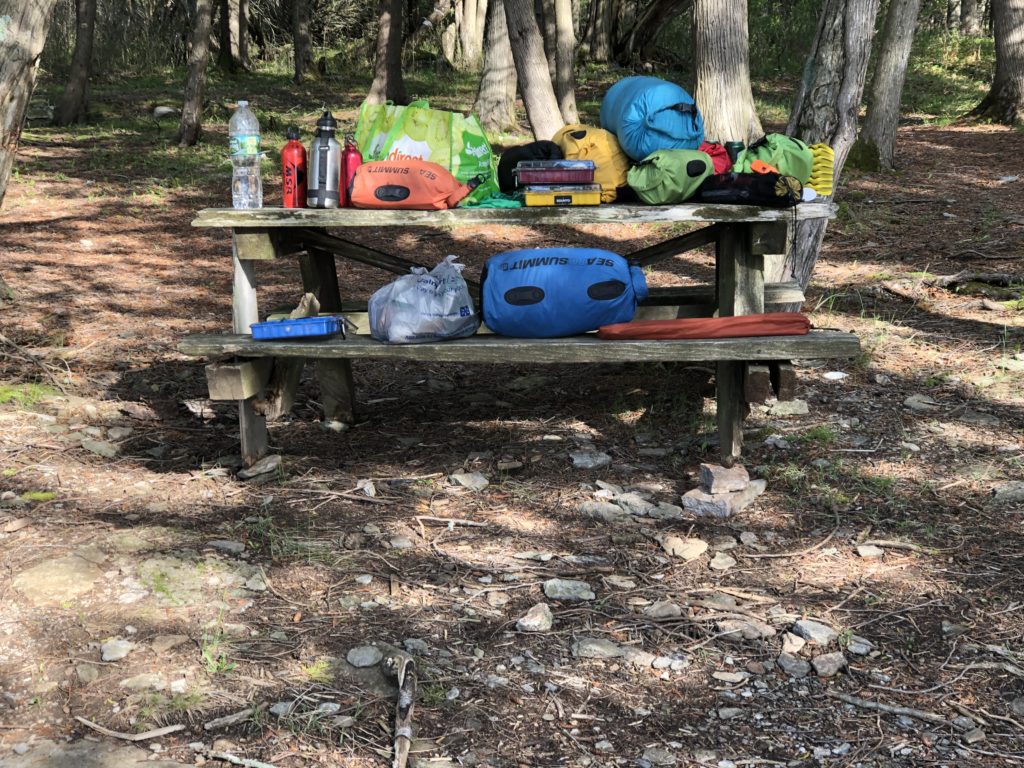
This was the first hard day, and the day things started to go off-plan. The water situation wasn’t dire but it was a learning experience. There’s nothing like having to paddle six miles out of your way in robust conditions, just because you didn’t grab that second three-liter bottle of water at the store.
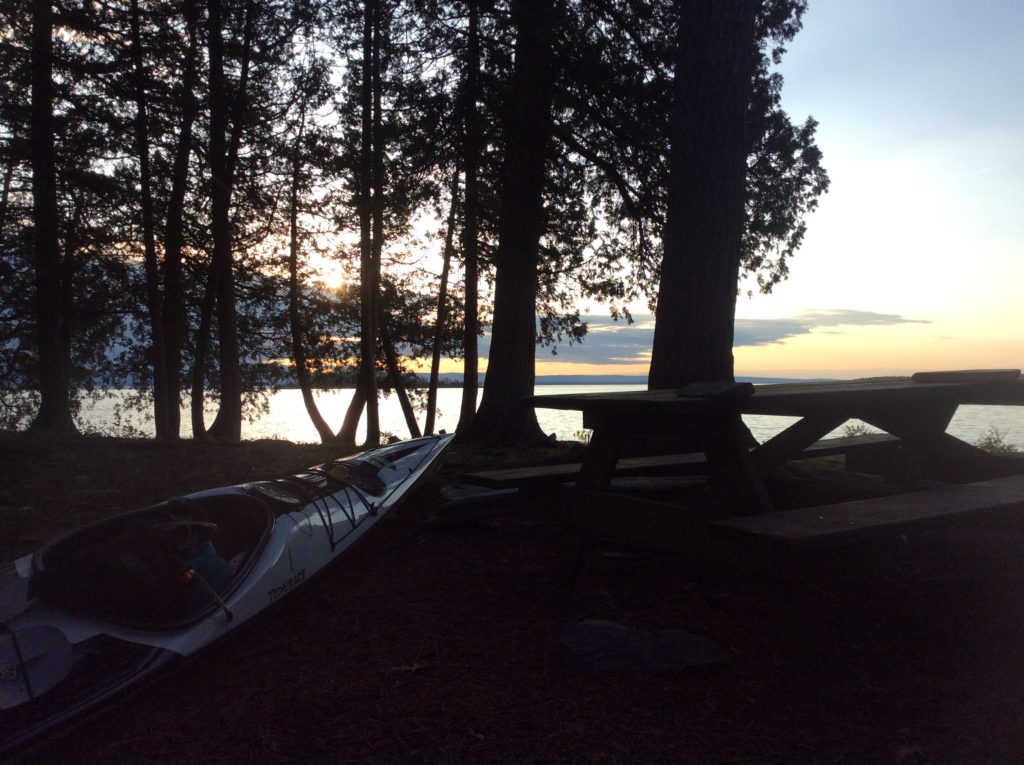
Law Island showed more signs of human activity, but once again I was apparently the only human on the island. Talking with SM later, the island is so close to nearby water access points that it’s pretty common for campers, yet early in the season when I was there.
I found a long piece of driftwood with some curious markings on it. I’m doubtful it was either fossils or scrimshaw, but something made some very interesting, natural-looking markings all up and down this stick.
Edited to Add: apparently these markings are from beetles. Thanks to BR for the knowledge!
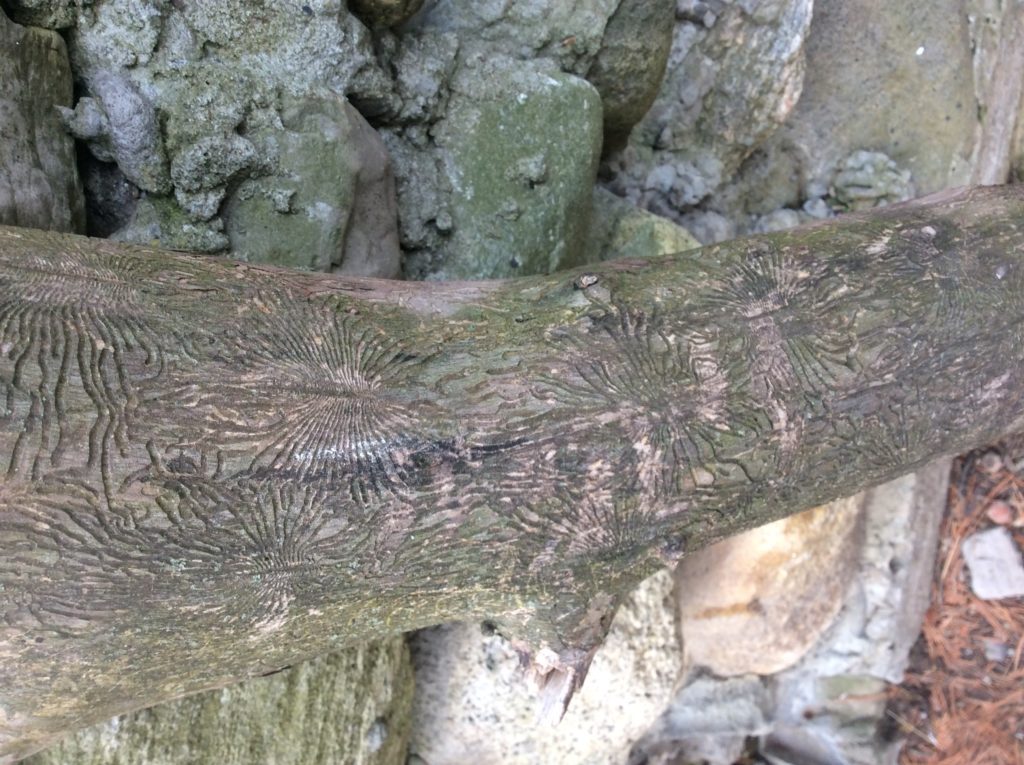
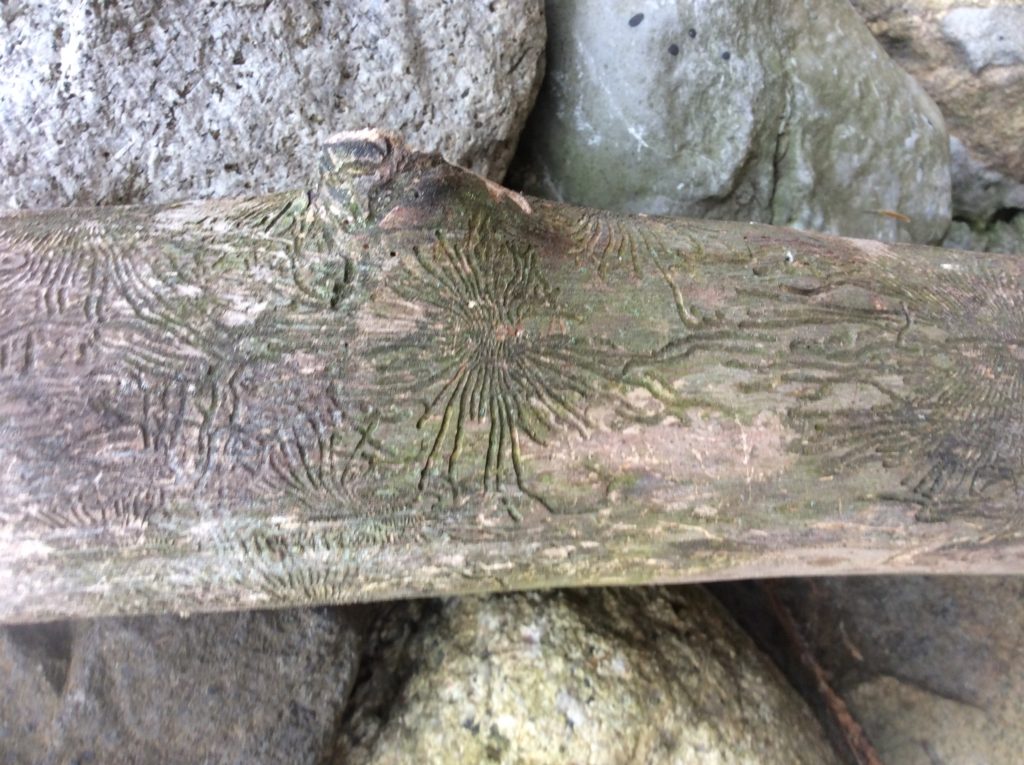
The rudder damage was a surprise, and I’m still not sure how it happened, or exactly when. I know the rudder came up properly when I landed for water, so it must have happened on the trip back, and before the portage. My best guess is that either the waves bounced the boat enough to work the pin loose (unlikely) or the drop rope got twisted around in a way that operating the rudder lifted it out, which also seems unlikely. In any case, I’ve replaced the entire assembly once before, so I have an idea of what’s involved. Hopefully I can replace just the pin. I would sorely miss that rudder on Day 5.
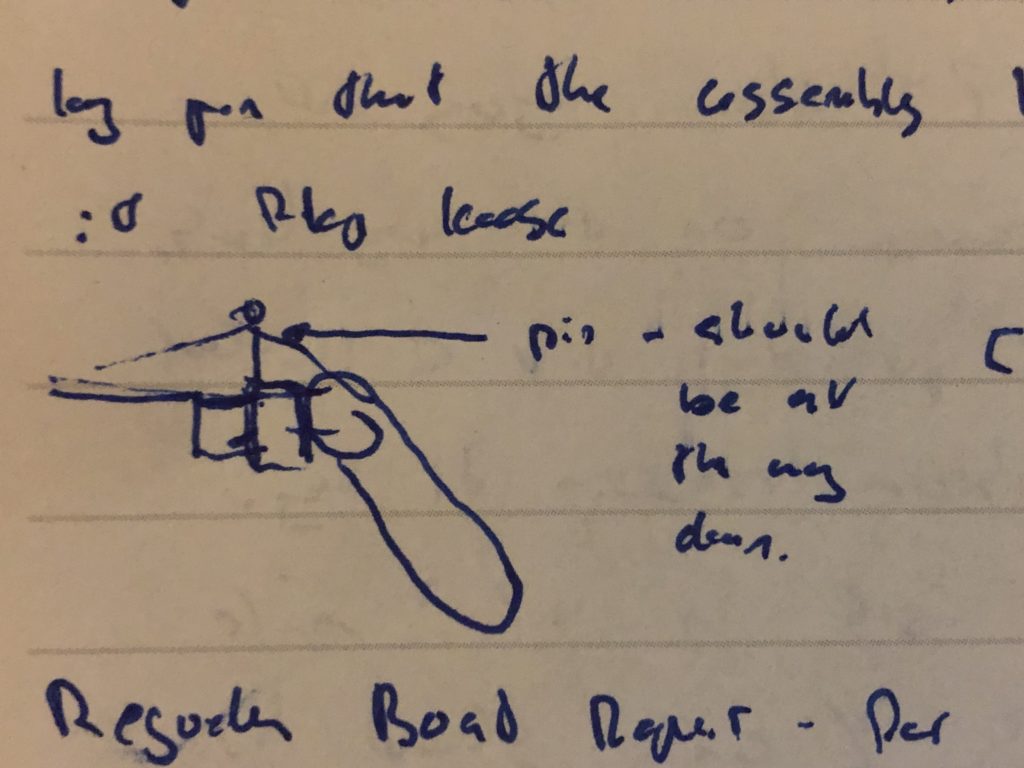
I turned the Pace 18 upside down in case of rain overnight. Just as on Valcour Island, I used logs to make the drag up the landing shore smoother, and to elevate the back so that the rudder wasn’t sticking into the ground.
Day 4
Weather predicted: F5 N till 1700, then down to F4.
Weather actual: F5 till about 1430, then down to F4 and even F3 by 1630. Cloudy.
Waves crashing constantly against the rocky shore. All night, a dull, slow roar, white noise. One side of the tent bears the wind directly, hobbled only by the picnic table and a couple of trees. From my tent I can see the remnants of waves jumping up from the rocks.
Because of these conditions, and yesterday’s exertions, I am staying in tent today. Anything new or interesting is at least four nautical miles away, and then I’d have to head back. Perhaps in the evening.
Went through kit. Mini first aid, attached bandages over area above right rear hip bone that was badly chafed.
The rudder definitely needs repair. The long pin that the assembly hinges on is up, making it flop loose.
I really like my tent. It is holding up well, though even inside my tent, the wind and waves seem relentless.
Regarding boat repair: for now I’ve put the rudder in the up position. This put tension on the line, so I used zip ties to hold the rudder up and attach to the thread hole. Also ran some dental floss through the hole, to sew the whole assembly, but I doubt the floss will hold much load.
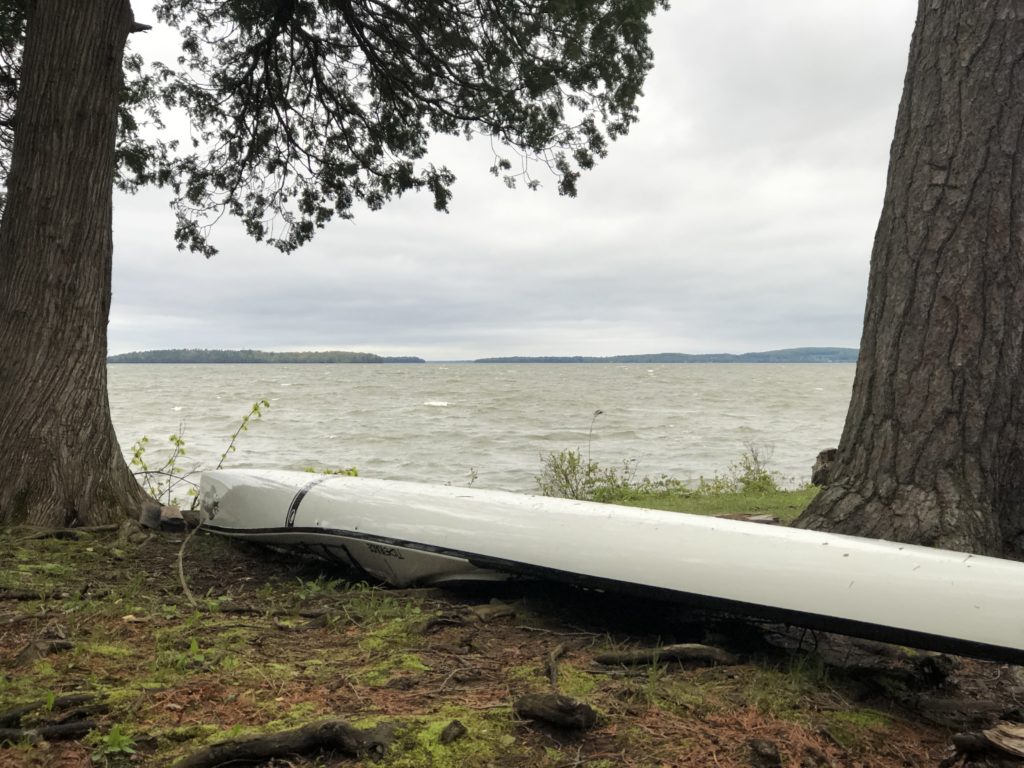
This was a relaxing day. I read. I napped. I played with my kit. I wrote in my journal. I took a closer look at the rudder. I bandaged some bad chafing. Mostly I rested – the past two days had been some hard paddling.
I also walked most of the way around Law Island. I couldn’t walk the entire coastline because of poison ivy and overgrowth, but I found other campsites, and signs of campfires, which are forbidden according to the guidebook. There are some great views of the lake, but more than a few minutes hike from where I landed.
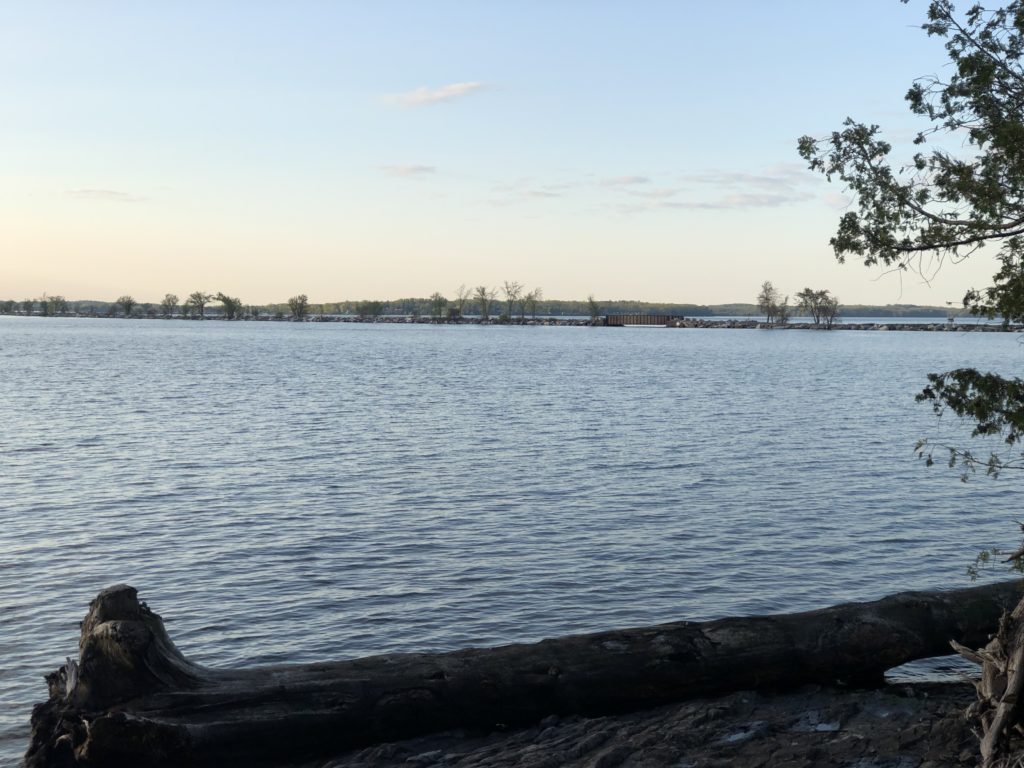
By 1430 the winds died down.
Radio WX observations at 1400 were: Burlington, Charlotte, 16 mph N, Plattsburgh, 9 mph NW. I was halfway between the two and it made sense that what I saw was relaxing wind.
I went for a short paddle, only an hour, 1545-1645, first to Sunset Island, paddled around it, there’s a small house there. Then, south to Charlotte Point, which was interesting.
Trees on the edge, their roots exposed, as if arrested mid-flight running over the cliff’s edge. Striated geology. Also this interesting structure in cliff face.
I paddled halfway to Arnold Point, close to shore, observing the houses on low-lying ground. Then back up north around Charlotte Point, much nicer houses with yards. Then on around Law Island, saw a brown-hooded bird with a narrowly tapered head.
Remembered how happy I was to see my tent yesterday. Made dinner, cleaned up, now watching the day end.
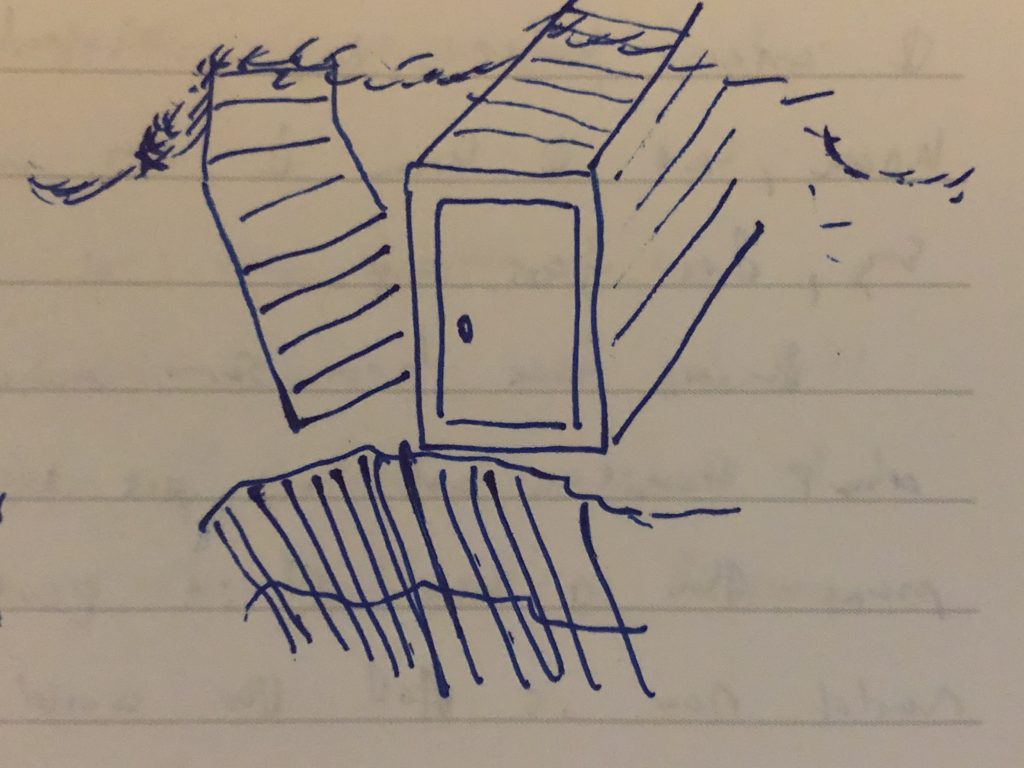
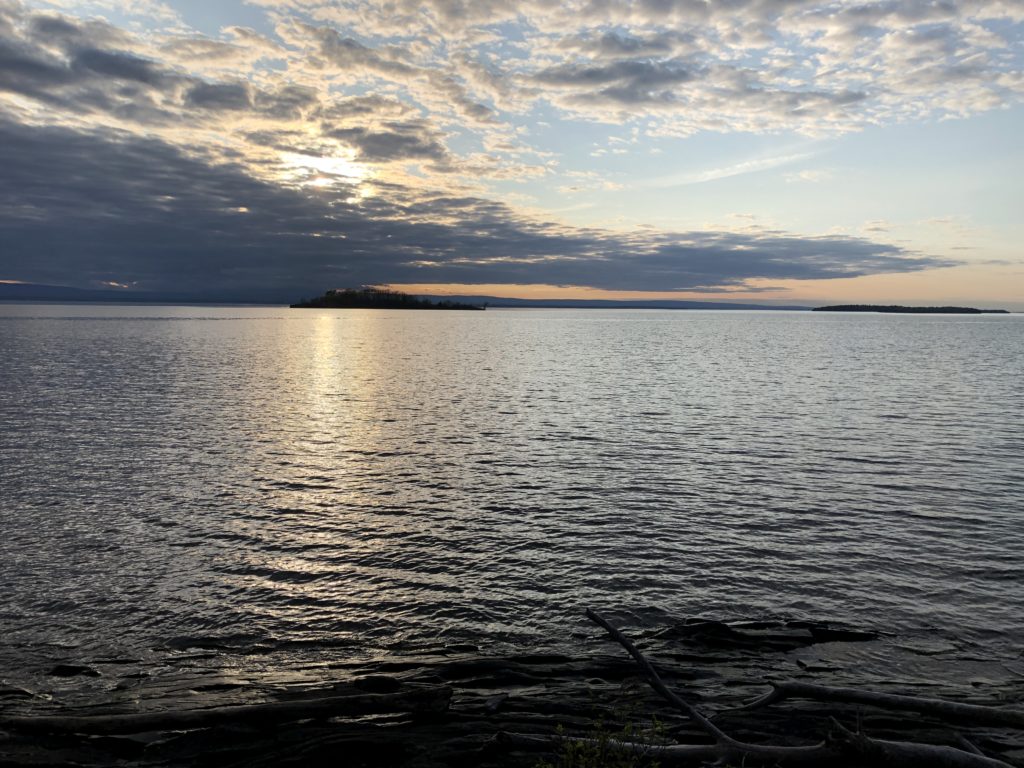
Day 5
A thick fog has settled in. I cannot see my closest island (Sunset Island), only a few minutes paddle away.
A course of magnetic 330 should get me to Providence, then magnetic 285 to Valcour.
Radio WX predicts clear and fair at Burlington.
Thinking of Benedict Arnold, before he turned traitor, having led the American fleet in retreat from the British near Valcour. How ridiculous that seemed to read. How believable it is in this thick soup.
Hoo boy. Of all the conditions I encountered, that fog was probably the most intimidating. I’ve paddled in fog, but very close to shore in areas that I know well. I’ve practiced working out a course on land and as well. However, looking at essentially two three-mile crossings in the thickest fog I’ve ever paddled in, when I couldn’t see the small island that was just over half a mile a way, well, that was a test of my confidence.
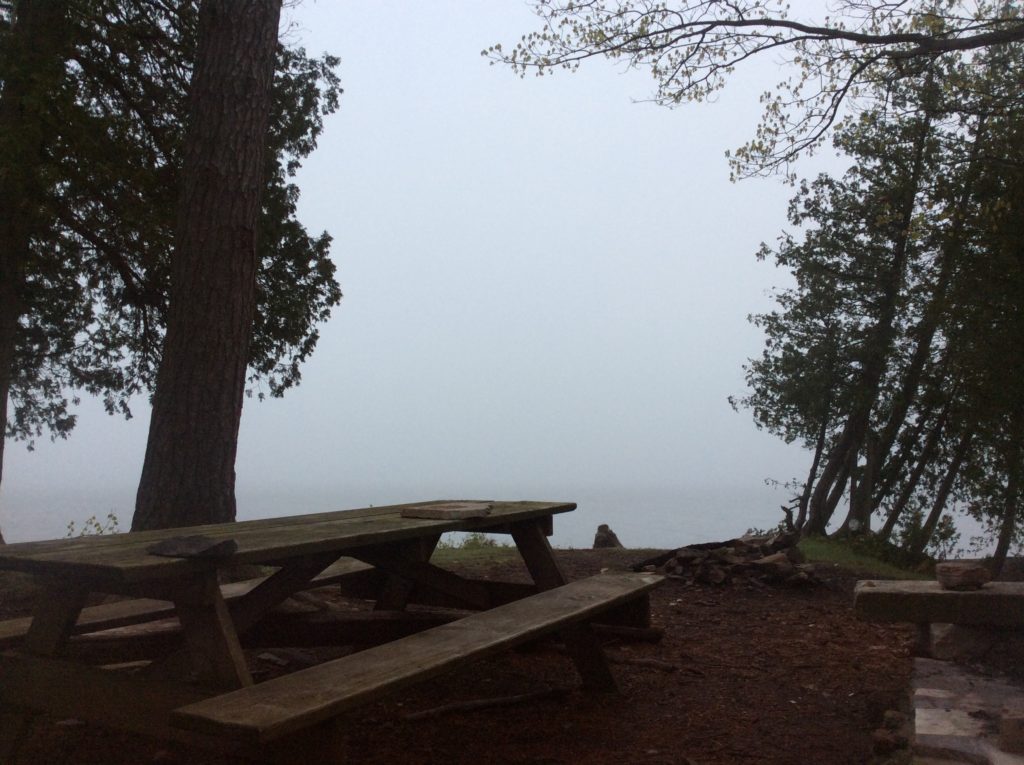
Even knowing what I needed to do, making it happen was hard. Basically the wind was blowing thirty degrees off from the direction I wanted to go, which meant I took quartering seas, which turned my boat just a bit, which meant I spent as much time controlling the boat as I did propelling the boat, which meant I didn’t have a very good idea of how fast I was going, so . . . that ten-minute paddle to my first landmark, was I missing it after fifteen minutes? Twenty minutes? Longer?
Eventually I gave up and paddled with the wind, figuring I’d either hit Stave Island (my next landmark) or Providence Island, which was the proverbial broad side of a barn. And, worst case, with the wind and conservative speed estimate, I figured after an hour and a half I could simply paddle due east and hit either Valcour or the opposite side of the lake within a couple of hours.
I think that in the time it took me to put on my spray deck, and struggle to keep on course, I was blown a bit further north, and then got turned around trying to find the island. After I turned north, eventually I did find Stave Island, but it was to the east of my position. Fortunately by then the fog was beginning to lift, and Providence (aptly named!) was visible over a mile away. By the time I made the big crossing, it was nearly all lifted.
In hindsight, I’d have done better to paddle a bit of a dog-leg course, traveling with the wind and using some dead reckoning to determine when to turn hard and take it abeam. A long, laden boat with a non-functional rudder in quartering seas was just too frustrating to deal with over a long haul.
In any event, I made it! There was quite a sense of accomplishment, in both conditions and distance. As I crossed, the Coast Guard periodically repeated a pan-pan for assistance regarding an empty dinghy found in a bay a few miles away. I saw two motorboats pass by, through the northern opening in the causeway. Otherwise, I saw no other vessels or signs of human activity until I landed back in Peru.
Afterwards
After I landed back at Peru, I texted MM, and SM came to pick me up in my own car. We chatted a bit while I finished unloading the boat and lifted it out of the way, so the various motorboats and houseboats could get out on the water for Memorial Day weekend.
While I was waiting, a young man from the NY EDC (environmental agency) came over and, after introductions, made a visual inspection of my vessel for milfoil. Lake Champlain is a center for various invasive species, and there are lots of signs and rules about cleaning off boats when transporting them from one waterway to another. It’s not something I normally have to worry about in my home waters.
After rinsing off drysuit and taking a long, hot shower, I repacked and organized my gear in the car. I took another visual inspection of the rudder and tied a more robust cord around it, lest it fly off at highway speeds. I made my goodbyes and then sent out for the five hour drive home.
Driving took a bit of concentration at first. There’s a difference in long-distance, slow-moving, eyeing-the-weather brain activity, versus high-speed, motorized, gauge-distance-and-velocity brain activity. It was like playing a video game after reading books for a week, which is more or less what I did.
Similarly, regular commercial transactions felt like a return to something once taken for granted. Pumping gas. Swiping a debit card. Ordering lunch at a diner. I’d just spent four and a half days in the woods, on the water, with hardly any human interaction, and nothing but my tent, boat, and their contents. It took the rest of the day to feel like I was really back in the world. I’m sure it’s only a taste of what people go through when off for much longer expeditions.
I used my boar repair kit. I used my first aid kit. I ran low on water. I paddled in hard wind and rain, and I navigated in fog. I enjoyed the entire trip.
I’ll have some more posts up looking a bit more retrospectively at the trip. And, I’ll post at some point about that whitewater safety class as well. For now, however, I’m happy to have made this journey, and to be home. I’ve paddled with my club since, and all my gear is cleaned and drying. It’s time for the summer to commence.

[…] meant that I didn’t have my own drysuit for my Lake Champlain camping trip. For that, I borrowed a womens drysuit with drop relief, and I have to say it was not terrible. In […]